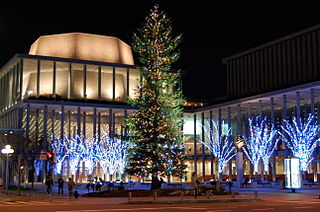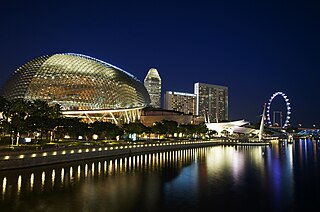
The John F. Kennedy Center for the Performing Arts is the United States National Cultural Center, located on the Potomac River in Washington, D.C. It was named in 1964 as a memorial to assassinated President John F. Kennedy. Opened on September 8, 1971, the center hosts many different genres of performance art, such as theater, dance, orchestras, jazz, pop, psychedelic, and folk music.

The Morton H. Meyerson Symphony Center is a concert hall located in the Arts District of downtown Dallas, Texas (USA). Ranked one of the world's greatest orchestra halls, it was designed by architect I.M. Pei and acoustician Russell Johnson's Artec Consultants, Inc. The structural engineers for this project was Leslie E. Robertson Associates, and opened in September 1989.

David Geffen Hall is a concert hall in New York City's Lincoln Center for the Performing Arts complex on Manhattan's Upper West Side. The 2,200-seat auditorium opened in 1962, and is the home of the New York Philharmonic.

Wallace Clement Sabine was an American physicist who founded the field of architectural acoustics. Sabine was the architectural acoustician of Boston's Symphony Hall, widely considered one of the two or three best concert halls in the world for its acoustics.

The Richard B. Fisher Center for the Performing Arts at Bard College is a performance hall located in the Hudson Valley hamlet of Annandale-on-Hudson, New York. The center provides audiences with performances and programs in orchestral, chamber, and jazz music, and in theater, dance, and opera. Designed by architect Frank Gehry, the 110,000-square-foot (10,000 m2) center houses two theaters, four rehearsal studios for dance, theater, and music, and professional support facilities. The building's heat and air-conditing systems are entirely powered by geothermal sources, enabling the Fisher Center to be fossil fuel free during standard operations. The total cost of the project reached $62 million and took three years to complete, opening in April 2003. The New Yorker calls it "[possibly] the best small concert hall in the United States."
The RiverCenter for the Performing Arts is a modern performance space in Downtown Columbus, Georgia, United States.

The Krannert Center for the Performing Arts is an educational and performing arts complex located at 500 South Goodwin Avenue in Urbana, Illinois and on the campus of the University of Illinois Urbana-Champaign. Herman C. Krannert, an industrialist who founded Inland Container Corporation and an alumnus of the university, and his wife, Ellnora Krannert, made a gift of $16 million that led to the Krannert Center's construction. Max Abramovitz, the architect who designed the facility, was also an Illinois alumnus.

The Wortham Theater Center is a performing arts center located in downtown Houston, Texas, United States. The Wortham Theater Center, designed by Eugene Aubry of Morris Architects, was built out of private funds totaling over $66 Million. The City of Houston owns the building, and the Houston First Corporation operates the facility.
The Broward Center for the Performing Arts is a large multi-venue performing arts center located in downtown Fort Lauderdale, Florida, United States.

Heinz Hall is a performing arts center and concert hall located at 600 Penn Avenue in the Cultural District of Pittsburgh, Pennsylvania. Home to the Pittsburgh Symphony Orchestra (PSO) and the Pittsburgh Youth Symphony Orchestra, the 2,676 seat hall presents about 200 performances each year. Originally built in 1927 as Loew's Penn Theatre, the former movie palace was renovated and reopened as Heinz Hall in 1971.

The Philharmonie Luxembourg, also known officially as the Grande-Duchesse Joséphine-Charlotte Concert Hall, is a concert hall located in the European district in the Luxembourg City quarter of Kirchberg. Opened in 2005, it now plays host to 400 performances each year.
J. Christopher Jaffe was recognized for leadership in architectural-acoustic design.
LARES is an electronic sound enhancement system that uses microprocessors to control multiple loudspeakers and microphones placed around a performance space for the purpose of providing active acoustic treatment. LARES was invented in Massachusetts in 1988, by Dr David Griesinger and Steve Barbar who were working at Lexicon, Inc. LARES was given its own company division in 1990, and LARES Associates was formed in 1995 as a separate corporation. Since then, hundreds of LARES systems have been used in concert halls, opera houses performance venues, and houses of worship from outdoor music festivals to permanent indoor symphony halls.

The Chan Centre for the Performing Arts is located on the campus of the University of British Columbia in Vancouver, British Columbia, Canada. It is situated within the natural landscape of the campus and is surrounded by evergreens and rhododendrons. This state of the art performing arts venue holds the 1,200-seat Chan Shun Concert Hall, the flexible-seating Telus Studio Theatre, the 160-seat Royal Bank Cinema, the Great Performers Lounge, and a glass lobby. Completed in 1997, the Chan Centre hosts classes, rehearsals and performances for a variety of the UBC departments of music, film and theatre as well as a diverse, yearly performing arts season that attracts audiences from all over the Lower Mainland.

Yasuhisa Toyota is a Japanese acoustician, who has been chief acoustician for over 50 projects worldwide, including the Walt Disney Concert Hall, Suntory Hall in Tokyo, the Bard College Performing Arts Center in New York, the Elbphilharmonie in Hamburg, and the Kauffman Center for the Performing Arts in Kansas City. He is the company director and U.S. Representative of Nagata Acoustics of Tokyo.

The Margot and Bill Winspear Opera House is an opera house located in the Arts District of downtown Dallas, Texas (USA).

The Hyogo Performing Arts Center (HPAC) is a performing arts center in the city of Nishinomiya, Hyōgo Prefecture, Japan, next to Nishinomiya-Kitaguchi Station operated by Hankyu Corporation. The Center was opened in 2005 to mark the ten-year anniversary of the Great Hanshin earthquake which largely devastated Nishinomiya and the surrounding cities.
Frederick Russell Johnson was an architect and acoustical expert. Johnson was the founder of Artec Consultants Incorporated in 1970. Nicknamed the "guardian of the ear" by Jean Nouvel in 1998 and an "acoustic guru" by others, Johnson was best known for works that included technical designs for the Morton H. Meyerson Symphony Center in Dallas, Texas, Jazz at Lincoln Center in New York, New Jersey Performing Arts Center, Centre in the Square in Canada, Pikes Peak Center in Colorado, Chan Centre for the Performing Arts in Canada and the Kravis Center for the Performing Arts in Florida.

Artec Consultants Inc, is an acoustics design and theater planning firm located in New York City. The company was founded by Frederick Russell Johnson in 1970. In 2013, Artec was integrated into the acoustic design and theater consulting practice Arup Group.

The Conrad Prebys Music Center (CPMC) is located on the campus of the University of California San Diego in La Jolla, California. The Music Center houses the university's music department, and is anchored by the 400-seat Concert Hall, in addition to the 170-seat Recital Hall and an Experimental Theatre with variable digital acoustics system.















